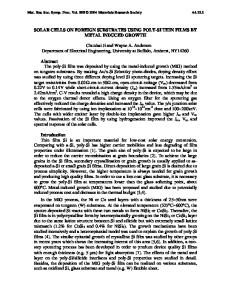Comparison of low temperature growth of Si thin films on amorphous substrates by MBE and PECVD methods
- PDF / 1,590,697 Bytes
- 6 Pages / 612 x 792 pts (letter) Page_size
- 15 Downloads / 281 Views
Comparison of low temperature growth of Si thin films on amorphous substrates by MBE and PECVD methods J. A. Anna Selvan, D. Grützmacher, E. Müller, M. Rebien1, M. Kummer2 , H. von Känel2, and J. Gobrecht Laboratory for Micro and Nanotechnology, Paul-Scherrer Institute, CH-5232 Villigen, Switzerland, 1Hahn-Meitner-Institut, Abt. Silicium-Photovoltaik, D-12489 Berlin, Germany, 2 Laboratorium für Festkoerperphysik, ETHZ,CH-8093 Zürich.e-mail: [email protected], ABSTRACT Low temperature growth of thin crystalline Si films on amorphous glass substrates by Molecular Beam Epitaxy (MBE) as well as by two different plasma enhanced chemical vapour deposition (PECVD) systems both using a DC plasma was carried out and the mictrostructural properties were analysed. In particular, the control over the texture along [220] orientation and the resulting columnar nature of the films were studied. The TEM cross section of Si films grown by MBE shows grains with an average width of 750 nm and a length of 3 microns. Using the low energy PECVD (LEPECVD) technique microcrystalline Si films were obtained with a growth rate of up to 35Å/sec. For high quality Si films with larger grains one may grow Si films by MBE whereas for Si films with passivated grain boundaries and for increased deposition rate, it is preferred to grow Si films by the newly developed methods of DC-PECVD. INTRODUCTION Hydrogenated microcrystalline Si and amorphous Si films receive commercial impetus because of their applications in solar cells, liquid crystal displays, image sensors, and printer arrays. The growth mechanisms and the control over the microstructural properties of Si films are crucial and they strongly depend on the growth technique. The most important method for growth of Si thin films is Plasma Enhanced Chemical Vapour Deposition (PECVD). However, the development of high quality microcrystalline Si on non epitaxial substrates such as glass, flexible polymers or metal is a challenging task. The control over the structure and the size of the grains, passivation of defects and grain boundaries is essential during the growth of microcrystalline silicon films. Modern device fabrication technologies require high crystal quality, preferably large grains in a columnar structure and a large growth rate, which is difficult to achieve at the same time[1]. Here we investigate new methods for the growth of Si thin films based on the low energy PECVD method[1, 2]. Using a low energy DC plasma (20-30V) the risk of ion-damage during deposition is minimised[2]. In addition, Molecular Beam Epitaxy (MBE) is used for comparison. EXPERIMENTAL The main features in our new DC-PECVD methods are the utilisation of high plasma density as well as low ion energy during growth with which one can obtain better microcrystalline Si films at higher growth rates. Two configurations of LEPECVD have been used. In the system hereafter called remote DC-PECVD, the plasma is ignited upstream of the substrate holder[1]. In the second system, the plasma is confined towards the substrate usin
Data Loading...








